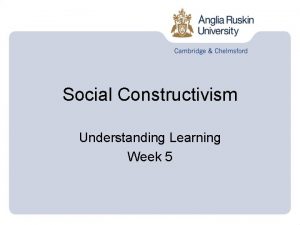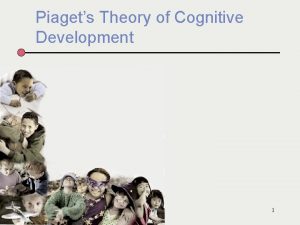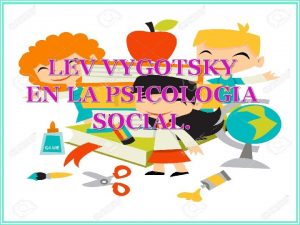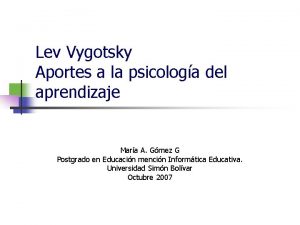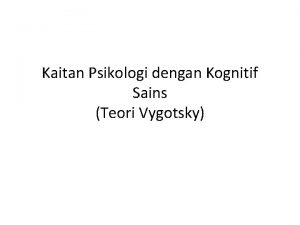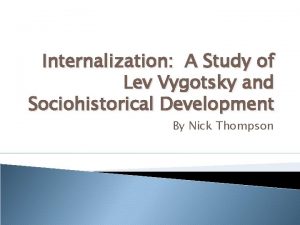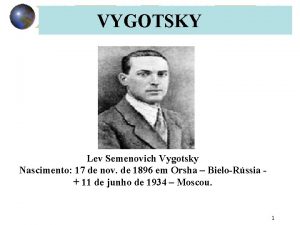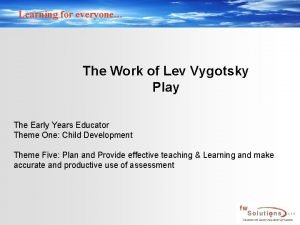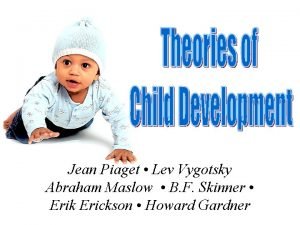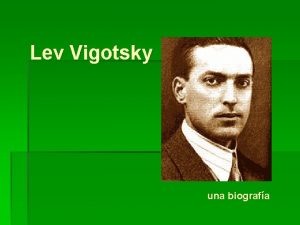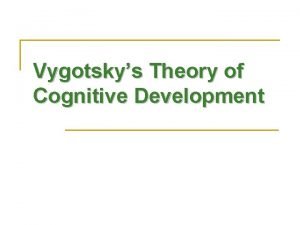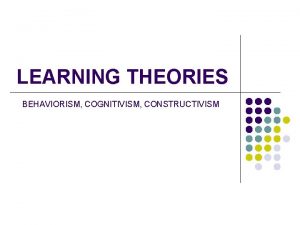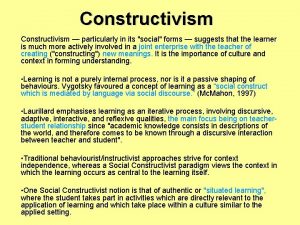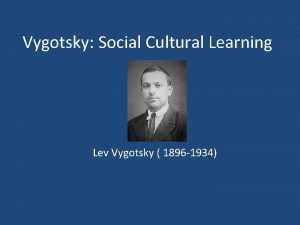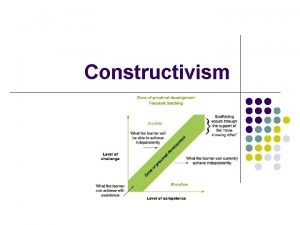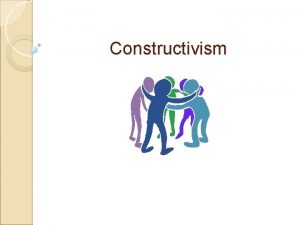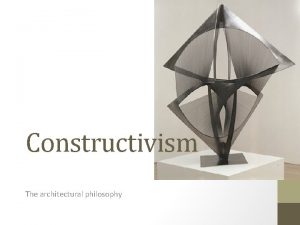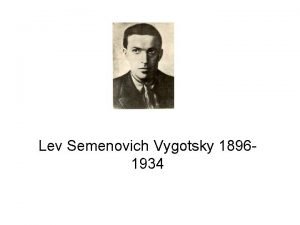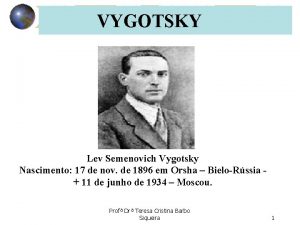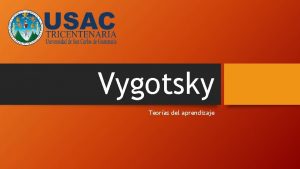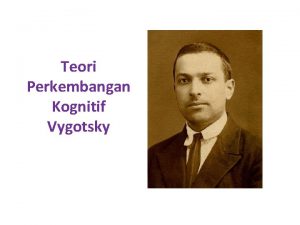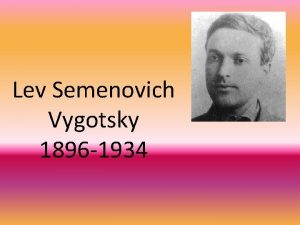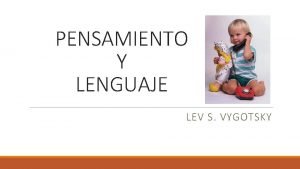Social Constructivism Understanding Learning Week 5 Lev Vygotsky

















- Slides: 17

Social Constructivism Understanding Learning Week 5

Lev Vygotsky (1896 -1934) • Russian psychologist (originally studied law) – active in 1920’s & 1930’s. Came to influence Western researchers mainly in 1960’s and 1980’s when translations of his work became available • Much of his research is based on language learning in children.

Lev Vygotsky: Ideas • Key ideas/concepts: cognitive development is essentially a social process. • Thought development is determined by language. • Intellectual growth is contingent upon the development of the social key of language. Social Development/Constructivist Theory • Definition: Social construction emphasizes the importance of culture and context in understanding what occurs in society and constructing knowledge based on this understanding (Pagram and Mc. Mahon, 1997) • Zone of Proximal Development (ZPD)

Lev Vygotsky: Social Development/Constructivist theory • Children do not develop in isolation but in a social world. • The child’s environment, age, culture and life experiences, social relationships and their interactions with other adults and children, need to be considered when reaching conclusions about children’s development. (socio-cultural influences) • Learning is based in real life experiences. Social and cultural interaction is vital for learning to take place.

Lev Vygotsky: Social Development/Constructivist theory • Language is essential to learning. It is the main means by which adults communicate and transmit information to children. • Children internalise language as thought and ‘inner speech’. Therefore, thought is the result of language. This is criticised by Fox (2001), who argued that if thought cannot exist without language, then until a child speaks; they must be devoid of thought.

Lev Vygotsky: Ideas • Zone of Proximal Development (ZPD) • Learning is accelerated through the learner working with or the teaching of a ‘More Knowledgeable Other’ Source http: //www. instructionaldesign. o rg/theories/socialdevelopment. html

Zone of Proximal Development • “…not a specific quality of the child, nor is it a specific quality of the educational setting or educators…it is… collaboratively produced in the interaction between the child and more knowledgeable others. The aim of the collaborative interaction is to lift the learner to become a ‘head taller’” (Vygotsky, 1978, p. 102)

Jerome Bruner (1915) • American psychologist. Focused on schooling in 1950’s. Bruner believed the role, purpose and method of education should reflect the values of society. • Influenced by Vygotsky and the social constructivist approach to learning. Bruner was interested in how context and culture influenced learning.

Jerome Bruner - Key ideas: Three modes of learning Bruner proposed they are three ways or modes of making sense of our world… Enactive: actions Muscle memory: a baby remembers how to shake a rattle, adult: how to type or drive a car. Iconic: images and pictures Information is stored as mental pictures. This is why diagram and images are useful to learning. Symbolic: Information is stored as a code, symbols and language. Symbols offer flexibility in that they can be manipulated, ordered and classified. They can also be used to describe and explain abstract information that cannot be explored through the enactive and iconic modes.

Jerome Bruner - Key ideas: Constructivist Learning is an active process. Learners construct new ideas/concepts based on current and previous learning. Bruner’s work supported discovery learning and children engaging in problem solving activities. Smidt (2011, p. 10) comments, “For Bruner, meaning has always been at the heart of any investigation into mind and cognition. When we talk of meaning we are talking about making sense of something, of understanding or comprehending it. ”

Jerome Bruner - Key ideas: Language is important in learning, as it helps learners to develop thinking skills, to problem solve and to deal with abstract concepts. Motivation Learners need to be interested and motivated to learn. Social learning Bruner like Vygostsky emphasised the social nature of learning and felt adults should play an active role in children’s learning. The teacher role is to facilitate learning and to encourage and support children to learn. Scaffolding Complex tasks are broken down into smaller tasks for the child to achieve. The adult works along side the child offering support. The support is gradually reduced as learning takes place and the child can work independently.

Jerome Bruner - Key ideas: Spiral curriculum – This opposes Piaget’s stages of learning and his concept of readiness to learn. Bruner argued that: • Schools waste time trying to match the complexity of subject material to a child’s cognitive stage of development. • Children are held back by teachers as certain topics are seen as too difficult to understand.

Spiral Approach Different topics are studied more than once. Each time they are revisited, it is at a deeper and more complex level. ‘We begin with the hypothesis that any subject can be taught effectively in some intellectually honest form to any child at any stage of development. ’ (Bruner, J. , 1960, The Process of Learning, Cambridge, Mass. : Harvard University Press) Advantage: A spiral curriculum can help learners to link a topic to a range of concepts, as it is revisited. Criticism: Some learners may view the spiral approach as too repetitive. Image from: Neary, M. , 2002, Curriculum Studies in Post-compulsory and Adult Education. Cheltenham: Nelson Thornes Ltd

Cognitivist: key impacts on learning • Child/learner centred approach to teaching and learning: Discovery learning; Active learning; Inquiry based learning; Reciprocal learning. • Teacher as facilitator: Role is guiding/helping student to learn rather than transmission of information – zone of proximal development and scaffolding. • Education is shaped by Society: Alignment with values and belief systems

References Atherton J. S. , 2011. Learning and Teaching; Piaget's developmental theory. Accessed 5 October 2012 from: http: //www. learningandteaching. info/learning/piaget. htm Calloway, W. R. , 2001. Jean Piaget: A Most Outrageous Deception. New York: NOVA Fox, R. 2001. Constructivism examined. Oxford Review of Education, 27, 1 23 -35. Gray, C. & Mac. Blain, S. 2012. Learning Theories in Childhood. London: Sage Mc. Leod, S. , 2012. Jean Piaget. Accessed 2 October 2012 from: http: //www. simplypsychology. org/piaget. html Meadows, M. , 1993. The Young Child as Thinker: The Cognitive Development and Acquisition of Cognition in Childhood. London: Routledge Pagram, J. & Mc. Mahon, M. 1997. We. B-CD: An Interactive Learning Experience for Distance Education Students Studying Interactive Multimedia. Poster presented at ICCE 97 International Conference on Computers in Education, Kuching, Malaysia, 2 -6 December. Piaget, J. P. , 1970. Science of Education and the Psychology of the Child. New York: Orion. Smidt, S. , 2011. Introducing Bruner: A Guide for Practitioners and Students in Early Years Education. London: Routledge Vygotsky, L. S. 1978. Mind in Society: The Development of Higher Psychological Processes. Cambridge, MA: Harvard University Press.

Further reading & resources – check the Weblinks section on the VLE. Cognitive Learning - general: http: //www. infed. org/biblio/learning-cognitive. htm Piaget: http: //www. learningandteaching. info/learning/piaget. htm http: //tip. psychology. org/piaget. html http: //www. simplypsychology. pwp. blueyonder. co. uk/piaget. html Vygotsky: http: //tip. psychology. org/vygotsky. html http: //www. learningandteaching. info/learning/constructivism. htm#Vygotsky http: //www. simplypsychology. pwp. blueyonder. co. uk/vygotsky. html Bruner: http: //www. infed. org/biblio/learning-cognitive. htm http: //tip. psychology. org/bruner. html http: //www. infed. org/thinkers/bruner. htm http: //www. simplypsychology. pwp. blueyonder. co. uk/bruner. html

Further reading: Cognitivist theorists Chapter 4 Cognitivist Theories in: Jarvis, P. , Holford, J. , Griffin, C. , 2003. Theory and Practice of Learning. 2 nd edn. London: Routledge (Ebook - library) Chapters 4, 5 & 7 in Gray, C. & Mac. Blain, S. 2012. Learning Theories in Childhood. London: Sage Publications Limited. pp. 212 -219 & pp. 225 -233 in Barlett, S & Burton, D. 2012. Introduction to Education Studies. Third Edition. London: Sage Publishing Limited. pp. 37 -62 & pp 337 -340 in Woolfolk, Hughes & Walkup. 2013. Psychology in Education. Second Edition. Harlow: Pearson
 Bruner social constructivism
Bruner social constructivism Lev vıgotski asya vigodskaya
Lev vıgotski asya vigodskaya Preoperational stage
Preoperational stage Vigotsky teoria
Vigotsky teoria Lev vygotsky aportes
Lev vygotsky aportes Lev vygotsky (1896-1934)
Lev vygotsky (1896-1934) Schema vygotsky
Schema vygotsky Biografi vygotsky
Biografi vygotsky Internalization vygotsky
Internalization vygotsky Lev vygotsky nascimento
Lev vygotsky nascimento Lev vygotsky play theory
Lev vygotsky play theory Jean piaget lev vygotsky
Jean piaget lev vygotsky Lev vygotsky nascimento
Lev vygotsky nascimento Herramientas vigotsky
Herramientas vigotsky Lev semenovich vygotsky theory
Lev semenovich vygotsky theory Behaviorism cognitivism
Behaviorism cognitivism Social constructivism
Social constructivism Week by week plans for documenting children's development
Week by week plans for documenting children's development
